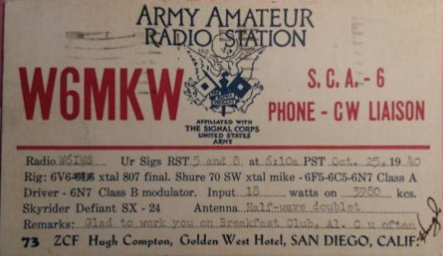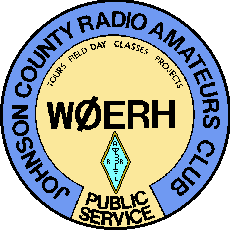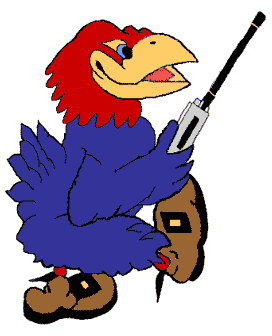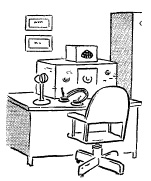 Since July I have been attending the School of Advanced Military Studies (SAMS) here at Ft. Leavenworth, KS. SAMS is a 10 month course that “educates the future leaders of our Armed Forces, our Allies, and the Interagency at the graduate level to be agile and adaptive leaders who think critically at the strategic and operational levels to solve complex ambiguous problems”. The majority of our classes are focused on the study and application of the elements of national power, international relations, and operational design. The end result is a planner who spends a year on a division or corps staff helping to draft campaign plans for operations. One of the requirements for graduation is to write a monograph (like a master’s thesis) on a topic relevant to the military. I chose as a topic to write about the history of the Army’s Military Affiliate Radio System (MARS).
Since July I have been attending the School of Advanced Military Studies (SAMS) here at Ft. Leavenworth, KS. SAMS is a 10 month course that “educates the future leaders of our Armed Forces, our Allies, and the Interagency at the graduate level to be agile and adaptive leaders who think critically at the strategic and operational levels to solve complex ambiguous problems”. The majority of our classes are focused on the study and application of the elements of national power, international relations, and operational design. The end result is a planner who spends a year on a division or corps staff helping to draft campaign plans for operations. One of the requirements for graduation is to write a monograph (like a master’s thesis) on a topic relevant to the military. I chose as a topic to write about the history of the Army’s Military Affiliate Radio System (MARS).
I’ve enjoyed researching the subject. Army MARS was officially constituted back in 1925 as the Army Amateur Radio System (AARS). I go a bit further back into history and trace the introduction of radio into Army use and then what circumstances brought about the requirements for the Army to want to organize something like the AARS.
Once organized, the AARS had a difficult start and then went through a fairly significant reorganization in 1929. There were a few reasons the Army wanted to establish the AARS. One was to extend the Army’s existing War Department Radio Net beyond the radio stations on Army installations to achieve a greater reach to all corners of the country. Knowing the limitations of wire (telephone and telegraph) communications during significant weather and natural disasters, the addition of AARS stations to the War Department Radio Net would help the local and Federal government better coordinate and respond to emergencies. The other major reason for the founding of AARS was to provide a pool of civilians trained in Army protocol for radio operations in case of a major conflict. The Army had learned from WWI that there was little time available to amass and train a significant force. Radio operators required specific skills which needed longer training. If a trained pool of operators was already in existence, it would make it that much easier to mobilize in case of general war.
AARS did serve as a benefit in providing communications during natural disasters. However, after the Pearl Harbor attack and the country began to mobilize, AARS literally evaporated. It was not used as a pool to draw from to bolster the Army’s Signal Corps. The organization basically ceased to exist until it was reconstituted as MARS some time after the conclusion of WWII. That is one area where I have been unable to find any definitive information as to why the Army chose not to draw from the AARS pool when they started full mobilization for WWII. And why was AARS abandoned and then another domestic organization (WERS – War Emergency Radio Service) stood up in its place? If you can help show me where I can find these answers, I’d greatly appreciate it.
ARRL and the amateur community had its own agenda in supporting AARS. Both before and after WWI, the amateurs (represented by ARRL) and the US government clashed over who should have privileges in the RF spectrum. The Navy was adamant about preventing the amateurs from retaining any RF privileges that might interfere with naval radio traffic. When the ARRL got the opportunity to affiliate with the US Army through AARS, they hoped it was an opportunity to help cement their hold over the amateur RF allocations by virtue of the proven service amateurs were providing the country.
It is an interesting topic and I am enjoying digging through old copies of QST as well a Army journals.
I’ve started writing and have my first 10 pages complete. I’ll post it here soon for comment.
If you have any specific knowledge of either AARS or MARS operation between 1925 and 1963, please let me know (scott dot hedberg at sign gmail dot com). I would enjoy getting some real history straight from a primary source.

 Last night I attended a meeting at the
Last night I attended a meeting at the  On Tuesday I attended the meeting of the
On Tuesday I attended the meeting of the  Thursday night I was out at the
Thursday night I was out at the  I enjoyed
I enjoyed  Scouts: received my Radio Merit Badge pamphlet in the mail today. Between the pamphlet and web resources, I want to put together a course package for the merit badge. One of the gentlemen I work with has a son who is interested in pursuing the Radio Merit Badge… so I need to get crackin’.
Scouts: received my Radio Merit Badge pamphlet in the mail today. Between the pamphlet and web resources, I want to put together a course package for the merit badge. One of the gentlemen I work with has a son who is interested in pursuing the Radio Merit Badge… so I need to get crackin’. This site is dedicated to the people providing emergency and backup communications in VA using Amateur Radio Digital modes. This is done by amateur radio operators on their own time and at their own expense as a public service to their communities and the state. VDEN supports both ARES and RACES operations. The primary 1200 baud frequencies are 145.73 and 446.075 with the UHF used as a backbone and forwarding frequency whenever possible. 441.050 (9600bps) is used for high speed connections from the greater Fredericksburg area, to the VA EOC and on down to the greater Tidewater area. Any frequency may be used for local operations but a link to 145.73, 441.050 or 446.075 is a must for relaying messages to the VA EOC. Keyboarding should NEVER be used during an activation or drill on 145.73! The ability of keyboarding to literally bring a network to a halt is as well known as is the infamous “dead carrier” that pops up during drills and activations. We also have Pactor operations as needed. When the network is not operating under a activation or drill, it functions as a normal statewide network. The term “network” is used to describe the emergency communications package that VDEN brings to Virginia. If you want to join the private, no spam, VDEN list server for system updates and information, please send me an
This site is dedicated to the people providing emergency and backup communications in VA using Amateur Radio Digital modes. This is done by amateur radio operators on their own time and at their own expense as a public service to their communities and the state. VDEN supports both ARES and RACES operations. The primary 1200 baud frequencies are 145.73 and 446.075 with the UHF used as a backbone and forwarding frequency whenever possible. 441.050 (9600bps) is used for high speed connections from the greater Fredericksburg area, to the VA EOC and on down to the greater Tidewater area. Any frequency may be used for local operations but a link to 145.73, 441.050 or 446.075 is a must for relaying messages to the VA EOC. Keyboarding should NEVER be used during an activation or drill on 145.73! The ability of keyboarding to literally bring a network to a halt is as well known as is the infamous “dead carrier” that pops up during drills and activations. We also have Pactor operations as needed. When the network is not operating under a activation or drill, it functions as a normal statewide network. The term “network” is used to describe the emergency communications package that VDEN brings to Virginia. If you want to join the private, no spam, VDEN list server for system updates and information, please send me an  December 04,2005
December 04,2005 As amateurs involved with emergency communications we typically think of a go kit as one containing the essentials we need to set up a mobile field station. In light of the events of the past week I thought I would preach to the choir.
As amateurs involved with emergency communications we typically think of a go kit as one containing the essentials we need to set up a mobile field station. In light of the events of the past week I thought I would preach to the choir.  Tonight I attended a class to become a
Tonight I attended a class to become a